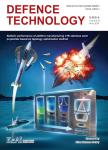Experimental investigation of Tie6Ale4V titanium alloy and 304L stainless steel friction welded with copper interlayer
Experimental investigation of Tie6Ale4V titanium alloy and 304L stainless steel friction welded with copper interlayer作者机构:Mechanical Engineering SKP Institute of Technology RMK College of Engineering and Technology
出 版 物:《Defence Technology(防务技术)》 (Defence Technology)
年 卷 期:2015年第11卷第1期
页 面:65-75页
核心收录:
学科分类:080503[工学-材料加工工程] 0806[工学-冶金工程] 0817[工学-化学工程与技术] 08[工学] 0805[工学-材料科学与工程(可授工学、理学学位)] 0802[工学-机械工程] 0703[理学-化学] 0701[理学-数学] 0801[工学-力学(可授工学、理学学位)] 0702[理学-物理学] 080201[工学-机械制造及其自动化]
基 金:The author is grateful to Welding Research Institute Trichy, for extending their facility for fabricating the samples for the above research work. The authors also wish to express their sincere thanks to all staff of the consulting department of WRI for their cooperation in the preparation of the samples
主 题:Friction welding Tie6Ale4V SS304L Oxygen free copper Interlayer Microstructure Interface
摘 要:The basic principle of friction welding is intermetallic bonding at the stage of super plasticity attained with self-generating heat due to friction and finishing at upset pressure. Now the dissimilar metal joints are especially popular in defense, aerospace, automobile, bio-medical,refinery and nuclear engineerings. In friction welding, some special alloys with dual phase are not joined successfully due to poor bonding strength. The alloy surfaces after bonding also have metallurgical changes in the line of interfacing. The reported research work in this area is scanty. Although the sound weld zone of direct bonding between Tie6Ale4 V and SS304 L was obtained though many trials, the joint was not successful. In this paper, the friction welding characteristics between Tie6Ale4 V and SS304 L into which pure oxygen free copper(OFC) was introduced as interlayer were investigated. Boxe Behnken design was used to minimize the number of experiments to be performed. The weld joint was analyzed for its mechanical strength. The highest tensile strength between Tie6Ale4 V and SS304 L between which pure copper was used as insert metal was acquired. Micro-structural analysis and elemental analysis were carried out by EDS, and the formation of intermetallic compound at the interface was identified by XRD analysis.



